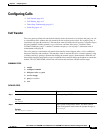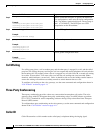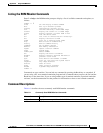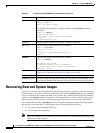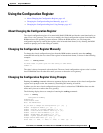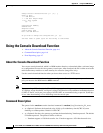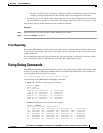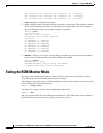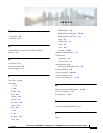
A-4
Cisco VG202, Cisco VG202XM, Cisco VG204, and Cisco VG204XM Voice Gateways Software Configuration Guide
OL-16191-01
Appendix A Using the ROM Monitor
Recovering Boot and System Images
Recovering Boot and System Images
If your voice gateway experiences difficulties and no longer contains a valid Cisco IOS software image
in flash memory, you can recover the Cisco IOS image by using the xmodem ROM monitor command.
Use this command if the computer attached to your console has a terminal emulator that has xmodem
capability. The xmodem command establishes a connection between a console and the voice gateway
console port for disaster recovery if both the boot and system images are erased from flash memory.
The syntax for the command is xmodem [filename]. The optional parameter argument filename specifies
the source file containing the Cisco IOS image. Other options include the following:
• -c—Use cyclic redundancy check (CRC-16).
• -y—Use Ymodem transfer protocol.
Note The Cisco VG202, Cisco VG202XM, Cisco VG204, and Cisco VG204XM voice gateways only
support the -c and -y options.
-? Displays information about command syntax; for example:
rommon 16 > dis -?
usage : dis [addr] [length]
The output for this command is slightly different for the xmodem download
command:
rommon 11 > xmodem -?
xmodem: illegal option -- ?
usage: xmodem [-cyrxu] <destination filename>
-c CRC-16
-y ymodem-batch protocol
reset or i Resets and initializes the voice gateway, similar to a power up.
dir device: Lists the files on the named device; for example:
rommon 5 > dir flash:
Directory of flash:
2 1343152 -rw- cVG204-advipservices-k9.mz
rommon 6 >
meminfo Lists the main memory information; for example:
rommon 6 > meminfo:
Main memory size: 128 MB.
Available main memory starts at 0x80018000
IO (packet) memory size: 5 percent of main memory
NVRAM size: 128 KB
boot commands
For more information about the ROM monitor boot commands, see the Cisco IOS
Configuration Fundamentals and Network Management Guide.
b Boots the first image in flash memory.
b flash: [filename] Attempts to boot the image directly from the first partition of flash memory. If you
do not enter a filename, this command will boot this first image in flash memory.
Table A-1 Commonly Used ROM Monitor Commands (continued)
Command Description





